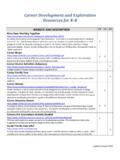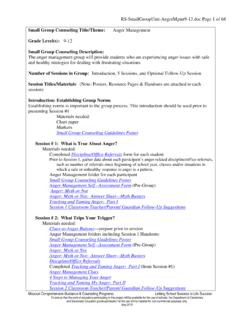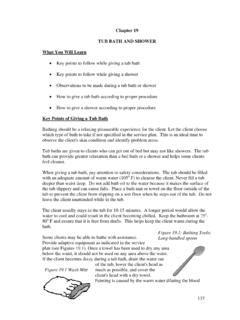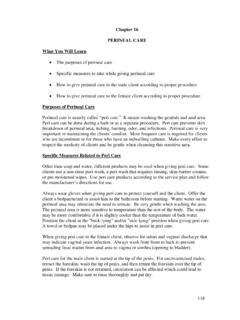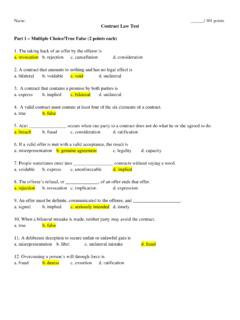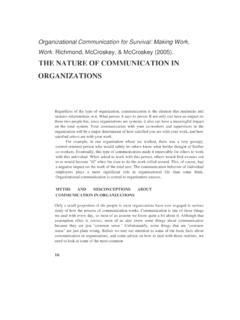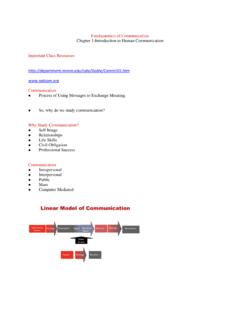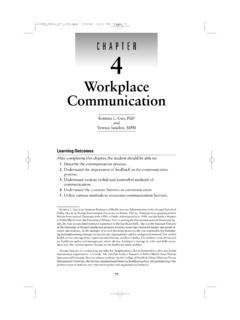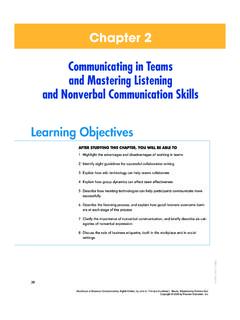Transcription of Chapter 4 COMMUNICATION SKILLS What You Will Learn
1 15 Chapter 4 COMMUNICATION SKILLS what You Will Learn The difference between verbal and nonverbal COMMUNICATION The difference between hearing and listening Factors that promote effective COMMUNICATION Barriers that prevent effective COMMUNICATION The correct way to answer the telephone in a client s home Methods of COMMUNICATION for clients who have difficulty communicating Verbal and nonverbal COMMUNICATION COMMUNICATION occurs when people share information with each other. There are two methods people use to communicate, verbal and nonverbal . Verbal COMMUNICATION is getting a message across through the use of the spoken word, written information or American sign language. You use verbal COMMUNICATION when you talk to clients and answer the telephone. nonverbal COMMUNICATION is also called body language. nonverbal COMMUNICATION sends a message across without the use of words.
2 Facial expression, gestures, posture, and tone of voice and touch are examples of nonverbal COMMUNICATION . nonverbal COMMUNICATION is used almost 100% of the time. When verbal and nonverbal messages match they can help to make a message clearer. If the verbal and nonverbal messages do not match, the other person may become confused. How Hearing and Listening Differ Listening is an important part of COMMUNICATION . It is an active effort to hear the message and understand it. Listening requires concentration and attention to what is being said. Hearing is a passive awareness of sound. To be a good listener you should: 1. STOP TALKING! You cannot listen if you are talking. 2. PUT THE SPEAKER AT EASE. Help the speaker feel free to talk. 3. SHOW THE SPEAKER THAT YOU WANT TO LISTEN. Look and act interested. Do not read your mail while someone is talking. Listen to understand rather than to reply.
3 16 4. REMOVE DISTRACTIONS. Don t doodle, tap, or shuffle papers. Shut the door if it will be quieter. 5. EMPATHIZE WITH THE SPEAKER. Try to put yourself in the speaker s place so that you can see his point of view. 6. BE PATIENT. Allow plenty of time. Do not interrupt. Do not start for the door or walk away. 7. KEEP YOUR ANGER UNDER CONTROL. An angry person gets the wrong meaning from words. 8. AVOID ARGUMENTS AND CRITICISM. Do not put the speaker on the defensive. The speaker may clam up or get angry. Try not to argue; even if you win, you lose! 9. ASK QUESTIONS. Encourage the speaker and show you are listening. Questions also help to develop further points. 10. STOP TALKING! This is first and last because all other listening SKILLS depend upon it. You just can t do a good listening job while you are talking. Nature gave people two ears but only one tongue, which is a hint that listening is more important than talking!
4 A good listener can make better decisions. Listening helps the speaker determine how well the message is being received. A good listener stimulates others to speak well. Good listening decreases misunderstandings. How to Communicate Effectively We are constantly communicating with other people. For COMMUNICATION to occur there must be a sender and a receiver. It takes work to be an effective communicator. Box lists some guidelines for effective COMMUNICATION . Box : Guidelines for effective COMMUNICATION Reminiscing is a way of reviewing life. It is a method that is sometimes used when communicating with the elderly. It helps the client to increase or regain self-esteem. Reminiscing may also help the client prepare for death. Pets also aid in COMMUNICATION . Some people can talk to a pet when they are unable to share their feelings with another person. Introduce yourself when meeting a new client Show an interest in talking with the client Be patient and allow time for talking Ask questions that will encourage the other person to continue speaking Pace yourself to the speed at which the client talks Try to get at the client s eye level and stay within sight Do not talk down to the client or use words he does not understand Speak clearly using a normal tone of voice Listen to the client s stories.
5 This allows them to feel important and that they had a meaningful life Use touch appropriately to convey caring 17 Remember, when you communicate you are not only conveying words but also your attitudes and feelings about yourself and others. Barriers that Limit COMMUNICATION Sometimes a message does not get through. If COMMUNICATION is not taking place, explore the reasons why. A person s language, culture, or personal beliefs may affect their ability to communicate effectively. Box lists behaviors that can be barriers to COMMUNICATION . Box : Barriers to COMMUNICATION Telephone COMMUNICATION When you answer the client s telephone you represent the agency that you work for. Answer the phone by the second ring if possible. Identify yourself and the client home. For example: Good afternoon, Belgrade residence, Sue speaking. May I help you? Speak in a moderate tone using clear and distinct words.
6 Smile when answering the phone. Your positive attitude will be heard by the caller. Keep paper and a pen by the phone for messages. When taking a message write down the following: Name of the caller Area code and phone number Date and time of the call The message followed by your initials Sometimes you may have to ask the caller if he can hold. If this happens, get back to the caller as soon as possible and apologize for the wait. The In-Home Aide may not make or accept personal calls while on duty in the client s home. Clients with COMMUNICATION Difficulties Some clients may have COMMUNICATION difficulties. Hearing, vision, and speech disorders are common problems. A client with a hearing impairment may lose interest in group activities or what is being said to him. Ignoring directions or inappropriate Changing the subject Giving your own opinion about the person and his situation without being asked Belittling a person s feelings Seeming to be too busy Jumping to conclusions before you know the entire story Giving false or inappropriate reassurances Interrupting Not waiting long enough for a reply Using words that sound alike or have a different meaning to the receiver than the sender intended.
7 For example, a plane is a flying vehicle. A plain is a wide, open field. 18 answers to questions may be seen. The hearing impaired client may attempt to lip read. When working with a client with a hearing impairment, encourage him to use a hearing aid and give him time to adjust it. Guidelines for communicating with someone who has a hearing impairment are listed in Box Common Hearing Aid Box : Communicating with a hearing impaired client Observe the client for signs of poor eyesight. Stumbling, falling, holding on to objects when walking and using touch to find things are signs the client may have difficulty seeing clearly. When caring for a client with vision problems, encourage the use of eyeglasses. Keep eyeglasses clean. Box lists guidelines for caring with a person with a vision problem. Box : Caring for a client with visual impairment Stand facing the client so that he can see you Get the client s attention by speaking directly to him Use moderate tone of voice; do not shout at the client Reduce background noise Use written COMMUNICATION if necessary Use facial expressions, gestures, and body language to express your meaning Power Switch: Off/Mike/Telephone Amplifier: Makes the sound louder Volume Control Battery compartment supplies electrical power Battery Speaker or receiver sends sound to plastic tubing Microphone: Sound enters aid and is picked up by the microphone Earmold: Prevents sound from leaking out of the ear Amplified sound goes to ear Use verbal COMMUNICATION if the client can hear Use a normal tone of voice Use touch Identify yourself when entering or leaving a room Keep the client s surroundings the same.
8 Do not rearrange personal items or furniture without asking the client. 19 Some clients may have speech disorders. Encourage clients to express themselves in any way possible. Continue to talk to the client and encourage others to do so also. Some clients with speech disorders also have trouble understanding the spoken word. Remember the client is an adult and treat him with respect. Box lists guidelines for communicating with clients who have speech disorders. Box : Communicating with a client with a speech disorder Remember, to be helpful you must Learn to communicate with your clients. If you have difficulty, try to determine the cause of the lack of COMMUNICATION . Review the information in this lesson often to keep yourself aware of the basic principles. Your effective COMMUNICATION SKILLS are extremely valuable to both you and others. Chapter Review 1. what is the difference between verbal and nonverbal COMMUNICATION ?
9 2. what is the difference between hearing and listening? 3. what factors promote effective COMMUNICATION ? 4. what are barriers that prevent effective COMMUNICATION ? 5. what is the correct way to answer the telephone in a client s home? 6. what methods of COMMUNICATION can be used with clients who have difficulty communicating? Watch the client for gestures or body movements that he may use for COMMUNICATION Be patient. Do not speak for the client. You may want to help him with words that are troublesome. Ask questions requiring a yes or no answer Use short, simple sentences, and use the same words each time when you give directions Speak slowly and clearly Use nonverbal cues, gestures, facial expressions, or pictures to augment spoken COMMUNICATION Follow service plan and instructions from the speech therapist to use alternative COMMUNICATION tools such as COMMUNICATION boards or picture books 20 Student Exercise 1.
10 what is the difference between verbal and non-verbal COMMUNICATION ? 2. List two examples of verbal COMMUNICATION . a. b. 3. List two examples of non-verbal COMMUNICATION . a. b. 4. (Circle) Which of the following is an example of an effective COMMUNICATION technique? a. Changing the subject. b. Showing interest in the client when he is talking. c. Giving a personal opinion about a person without being asked. d. Jumping to conclusions without knowing the whole story. 5. what is the correct way to answer the telephone at a client's home? 6. what is the difference between hearing and listening? Circle an (E) if the statement represents effective COMMUNICATION or a (B) if the statement represents a COMMUNICATION barrier. 7. E / B If COMMUNICATION is not taking place, explore the reasons. 8. E / B Allow time for the client to talk and express his feelings.
